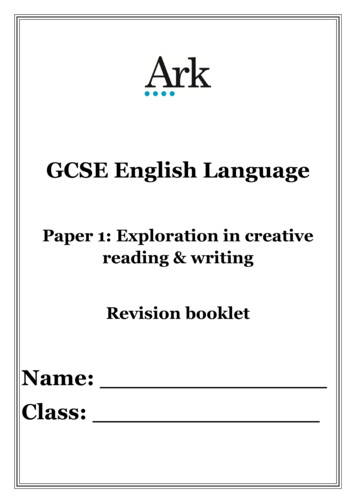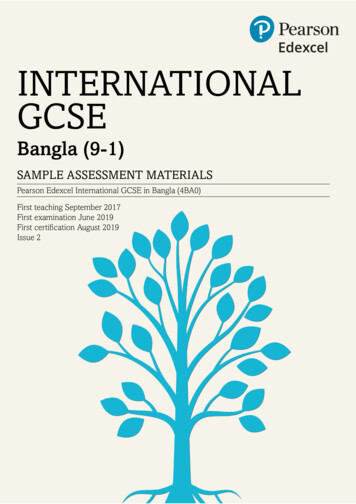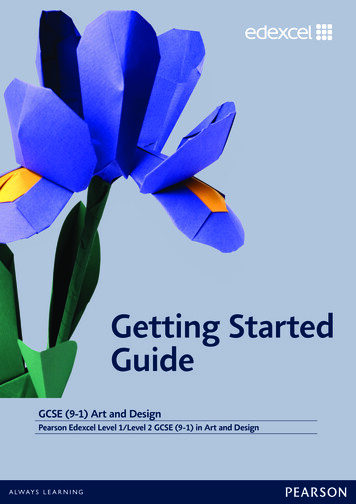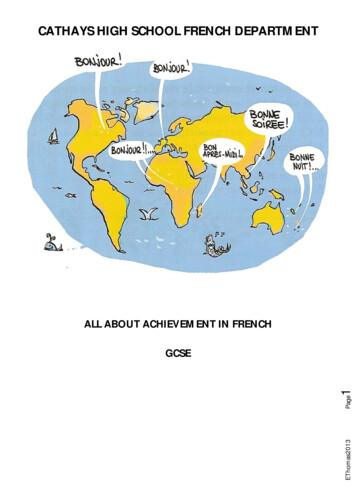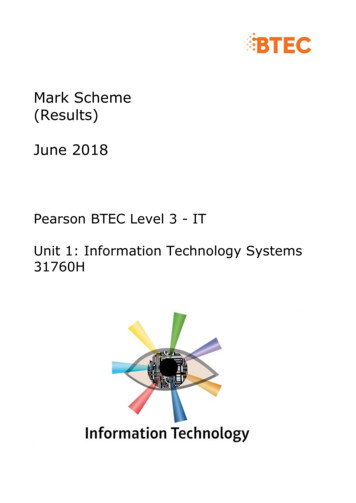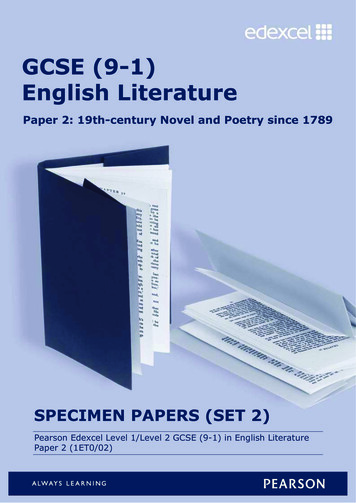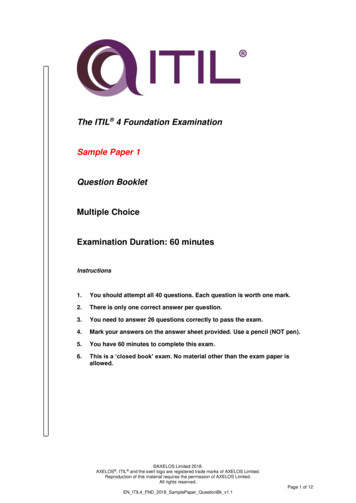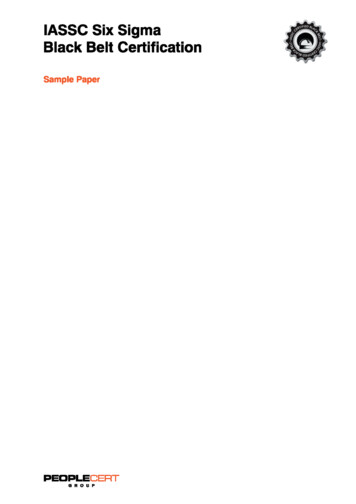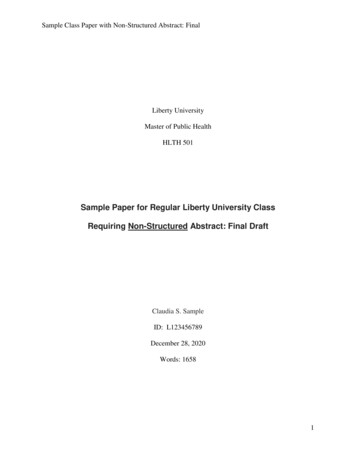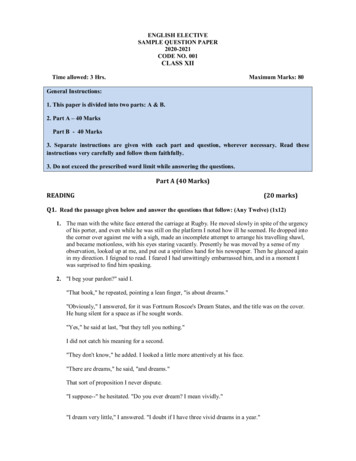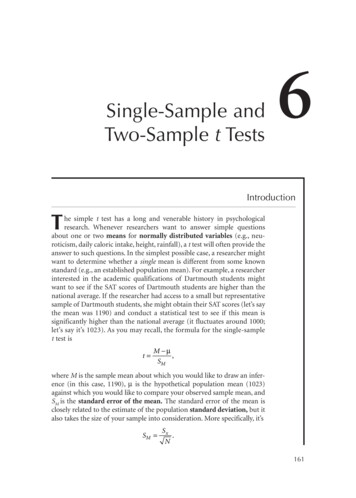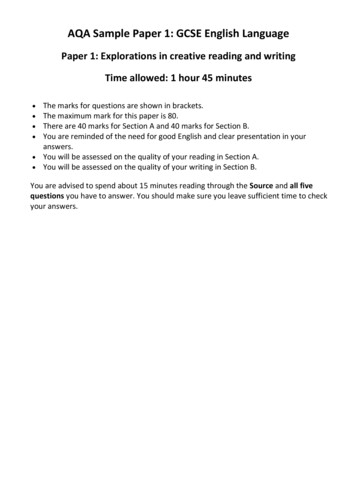
Transcription
AQA Sample Paper 1: GCSE English LanguagePaper 1: Explorations in creative reading and writingTime allowed: 1 hour 45 minutes The marks for questions are shown in brackets.The maximum mark for this paper is 80.There are 40 marks for Section A and 40 marks for Section B.You are reminded of the need for good English and clear presentation in youranswers. You will be assessed on the quality of your reading in Section A. You will be assessed on the quality of your writing in Section B.You are advised to spend about 15 minutes reading through the Source and all fivequestions you have to answer. You should make sure you leave sufficient time to checkyour answers.
Source AThis extract is from a novel by Yann Martel. In this section the central character, Pi, is on a sinking ship.The ship is carrying the animals belonging to Pi’s father, who owns a zoo.Life of Pi1234567Inside the ship, there were noises. Deep structural groans. I stumbled and fell. No harm done. I gotup. With the help of the handrails I went down the stairwell four steps at a time. I had gone downjust one level when I saw water. Lots of water. It was blocking my way. It was surging from belowlike a riotous crowd, raging, frothing and boiling. Stairs vanished into watery darkness. I couldn'tbelieve my eyes. What was this water doing here? Where had it come from? I stood nailed to thespot, frightened and incredulous and ignorant of what I should do next. Down there was wheremy family was.89101112I ran up the stairs. I got to the main deck. The weather wasn't entertaining any more. I was veryafraid. Now it was plain and obvious: the ship was listing badly. And it wasn't level the other wayeither. There was a noticeable incline going from bow to stern. I looked overboard. The waterdidn't look to be eighty feet away. The ship was sinking. My mind could hardly conceive it. It wasas unbelievable as the moon catching fire.131415161718Where were the officers and the crew? What were they doing? Towards the bow I saw some menrunning in the gloom. I thought I saw some animals too, but I dismissed the sight as illusion craftedby rain and shadow. We had the hatch covers over their bay pulled open when the weather wasgood, but at all times the animals were kept confined to their cages. These were dangerous wildanimals we were transporting, not farm livestock. Above me, on the bridge, I thought I heardsome men shouting.19202122The ship shook and there was that sound, the monstrous metallic burp. What was it? Was it thecollective scream of humans and animals protesting their oncoming death? Was it the ship itselfgiving up the ghost? I fell over. I got to my feet. I looked overboard again. The sea was rising. Thewaves were getting closer. We were sinking fast.232425I clearly heard monkeys shrieking. Something was shaking the deck, a gaur - an Indian wild ox exploded out of the rain and thundered by me, terrified, out of control, berserk. I looked at it,dumbstruck and amazed. Who in God's name had let it out?262728293031323334I ran for the stairs to the bridge. Up there was where the officers were, the only people on theship who spoke English, the masters of our destiny here, the ones who would right this wrong.They would explain everything. They would take care of my family and me. I climbed to the middlebridge. There was no one on the starboard side. I ran to the port side. I saw three men, crewmembers. I fell. I got up. They were looking overboard. I shouted. They turned. They looked at meand at each other. They spoke a few words. They came towards me quickly. I felt gratitude andrelief welling up in me. I said, "Thank God I've found you. What is happening? I am very scared.There is water at the bottom of the ship. I am worried about my family. I can't get to the levelwhere our cabins are. Is this normal? Do you think-"3536373839One of the men interrupted me by thrusting a life jacket into my arms and shouting something inChinese. I noticed an orange whistle dangling from the life jacket. The men were noddingvigorously at me. When they took hold of me and lifted me in their strong arms, I thought nothingof it. I thought they were helping me. I was so full of trust in them that I felt grateful as theycarried me in the air. Only when they threw me overboard did I begin to have doubts.
Section A: ReadingAnswer all questions in this section.You are advised to spend about 45 minutes on this section.Q1. Read again the first part of the Source from lines 1 to 12.List four things from this part of the text about the ship.[4 marks]Q2. Look in detail at this extract from lines 13 to 25 of the Source:Where were the officers and the crew? What were they doing? Towards the bow I saw some menrunning in the gloom. I thought I saw some animals too, but I dismissed the sight as illusion craftedby rain and shadow. We had the hatch covers over their bay pulled open when the weather wasgood, but at all times the animals were kept confined to their cages. These were dangerous wildanimals we were transporting, not farm livestock. Above me, on the bridge, I thought I heardsome men shouting.The ship shook and there was that sound, the monstrous metallic burp. What was it? Was it thecollective scream of humans and animals protesting their oncoming death? Was it the ship itselfgiving up the ghost? I fell over. I got to my feet. I looked overboard again. The sea was rising. Thewaves were getting closer. We were sinking fast.I clearly heard monkeys shrieking. Something was shaking the deck, A gaur-an Indian wild oxexploded out of the rain and thundered by me, terrified, out of control, berserk. I looked at it,dumbstruck and amazed. Who in God's name had let it out?How does the writer use language here to describe the narrator’s fright and confusion?You could include the writer’s choice of: words and phrases language features and techniques sentence forms[8 marks]
Q3. You now need to think about the whole of the Source.This extract comes at the end of a chapter.How has the writer structured the text to interest you as a reader?You could write about: what the writer focuses your attention on at the beginning how and why the writer changes this focus as the Source develops any other structural features that interest you[8 marks]Q4. Focus this part of your answer on the second part of the Source from line 19 to theend.A student, having read this section of the text, said: ‘The writer makes the reader feelsympathetic for the narrator.’To what extent do you agree?In your response, you could: write about your own impressions of the narrator evaluate how the writer has created these impressions support your opinions with references to the text[20 marks]
Section B: WritingYou are advised to spend about 45 minutes on this section.Write in full sentences.You are reminded of the need to plan your answer.You should leave enough time to check your work at the end.Q5. You are going to enter a creative writing competition.Your entry will be judged by a panel of people of your own age.Either: Write a description suggested by this picture:Or: Write a story opening in which a dramatic event occurs.(24 marks for content and organisation16 marks for technical accuracy)[40 marks]
AQA GCSE English LanguagePaper 1: Explorations in creative reading and writingMark SchemeQ1. Read again the first part of the Source from lines 1 to 12.List four things from this part of the text about the ship.[4 marks]Give 1 mark for each point about the ship: responses must be true, and only drawn from lines 1 to 12 of the text responses must relate to the ship students may quote or paraphrase a paraphrased response covering more than one point should be credited for eachpoint made – though paraphrased responses must demonstrate evidence ofidentification of information that is specific to the focus of the question asrequired by AO1 responses that copy the whole section of the text from lines 1 to 12 verbatimshould not be credited any marks as this does not provide any evidence ofidentification of information that is specific to the focus of the question asrequired by AO1Indicative content; students may include: There were noises inside the ship There are stairs with a handrail There is water at the bottom of the stairwell The water is ‘surging from below’ It is dark at the bottom of the stairs The narrator’s family are somewhere inside the shipOr any other valid responses you are able to verify by checking the Source.
Q2. Look in detail at this extract from lines 13 to 25 of the Source. (Extract in paper.)How does the writer use language here to describe the narrator’s fright and confusion? [8marks]Level 4Detailed, perceptiveanalysis7-8 marksLevel 3Clear, relevantexplanation5-6 marksLevel 2Some understandingand comment3-4 marksLevel 1Simple, limitedcomment1-2 marksLevel 0No marksAnalyses the effects of the writer’s choices of language Selects a judicious range of textual detail Makes sophisticated and accurate use of subjectterminology Explains clearly the effects of the writer’s choice oflanguage Selects a range of relevant textual detail Makes clear and accurate use of subject terminology Attempts to comment on the effect of language Selects some appropriate textual detail Makes some use of subject terminology, mainlyappropriately Offers simple comment on the effect of language Selects simple references or textual details Makes simple use of subject terminology, not alwaysappropriatelyNo comments on the use of language.Nothing to reward. AO2 content may include the effect of ideas such as: repeated use of questions use of long and short sentences to create different effects use of lexis, e.g. verbs and adjectives employing imagery such as metaphor/personification
Q3. You now need to think about the whole of the Source.This extract comes at the end of a chapter.How has the writer structured the text to interest you as a reader?Level 4Detailed, perceptiveanalysis7-8 marksLevel 3Clear, relevantexplanation5-6 marksLevel 2Some understandingand comment3-4 marksLevel 1Simple, limitedcomment1-2 marksLevel 0No marks[8 marks]Analyses the effects of the writer’s choice of structuralfeatures Selects a judicious range of examples Makes sophisticated and accurate use of subjectterminology Explains clearly the effects of the writer’s choice ofstructural features Selects a range of relevant examples Makes clear and accurate use of subject terminology Attempts to comment on the effect of structuralfeatures Selects some appropriate examples Makes some use of subject terminology, mainlyappropriately Offers simple comment on the effect of structuralfeatures Selects simple references or examples Makes simple use of subject terminology, not alwaysappropriatelyNo comments on the use of structure.Nothing to reward. AO2 content may include the effect of ideas such as: the narrator’s gradual realisation of what is happening – built up in each paragraph change of focus from inside to outside consistent reminder of the storm and water, recapitulated throughout the text the narrator’s awareness of the animals on board (he thinks he sees escapedanimals but dismisses it, then clearly hears monkeys shrieking, then sees an out ofcontrol ox) use of a ‘cliff hanger’ at the end of the chapter
Q4. Focus this part of your answer on the second part of the Source from line 19 to theend.A student, having read this section of the text, said: ‘The writer makes the reader feelsympathetic for the narrator.’To what extent do you agree?Level 4Detailed, perceptiveevaluation16-20 marksLevel 3Clear, relevantevaluation11-15 marksLevel 2Some evaluation6-10 marksLevel 1Simple, limitedevaluation1-5 marksLevel 0No marks[20 marks]Evaluates critically and in detail the effect(s) on thereader Shows perceptive understanding of writer’s methods Shows a judicious range of textual detail Develops a convincing and critical response to the focusof the statement Evaluates clearly the effect(s) on the reader Shows clear understanding of writer’s methods Selects a range of relevant textual references Makes a clear and relevant response to the focus of thestatement Makes some evaluative comment(s) on effect(s) onreader Shows some understanding of writer’s methods Selects some appropriate textual reference(s) Makes some response to the focus of the statement Makes simple, limited evaluative comment(s) oneffect(s) on reader Shows limited understanding of writer’s methods Selects simple, limited textual reference(s) Makes a simple, limited response to the focus of thestatementNo relevant comments offered in response to thestatement, no impressions, no evaluation. AO4 content may include the evaluation of ideas such as: use of questions and gradual revelation of what is happening conveys narrator’sconfusion narrator’s reactions to what is happening confused communication with the crew members narrator is alone at the end of the chapter how the writer has used, for example, language, structure, tone to make animpression on the reader
Q5. You are going to enter a creative writing competition.Your entry will be judged by a panel of people of your own age.Either: Write a description suggested by this picture: (picture of a petrol station that hasfallen into a crack in the earth).Or: Write a story opening in which a dramatic event occurs.(24 marks for content and organisation16 marks for technical accuracy)[40 marks]AO5 Content and Organisation
AO6 Technical Accuracy
AQA Sample Paper: GCSE English LanguagePaper 1: Explorations in creative reading and writingTime allowed: 1 hour 45 minutes The marks for questions are shown in brackets.The maximum mark of this paper is 80.There are 40 marks for Section A and 40 marks for Section B.You are reminded of the need for good English and clear presentation in youranswers. You will be assessed on the quality of your reading in Section A. You will be assessed on the quality of your writing in Section B.You are advised to spend about 15 minutes reading through the Source and all fivequestions you have to answer. You should make sure you leave sufficient time to checkyour answers.
Source AThis extract is from the first chapter of a novel by Donna Tartt.The Goldfinch1234Things would have turned out better if my mother had lived. As it was, she died when I was a kid;and though everything that’s happened to me since then is thoroughly my own fault, still when Ilost her I lost sight of any landmark that might have led me someplace happier, to some morepopulated or congenial* life.567891011121314151617Her death the dividing mark: Before and After. And though it’s a bleak thing to admit all theseyears later, still I’ve never met anyone who made me feel loved the way she did. Everything camealive in her company; she cast a charmed theatrical light about her so that to see anything throughher eyes was to see it in brighter colours than ordinary – I remember a few weeks before she died,eating a late supper with her in an Italian restaurant down in the Village, and how she grasped mysleeve at the sudden, almost painful loveliness of a birthday cake with lit candles being carried inprocession from the kitchen, faint circle of light wavering in across the dark ceiling and then thecake set down to blaze amidst the family, beatifying* an old lady’s face, smiles all round, waitersstepping away with their hands behind their backs – just an ordinary birthday dinner you mightsee anywhere in an inexpensive downtown restaurant, and I’m sure I wouldn’t even remember ithad she not died so soon after, but I thought about it again and again after her death and indeedI’ll probably think about it all my life: that candlelit circle, a tableau vivant* of the daily,commonplace happiness that was lost when I lost her.181920She was beautiful, too. That’s almost secondary; but still, she was. When she came to New Yorkfresh from Kansas, she worked part-time as a model though she was too uneasy in front of thecamera to be very good at it; whatever she had, it didn’t translate to film.212223242526272829303132333435363738And yet she was wholly herself: a rarity. I cannot recall ever seeing another person who reallyresembled her. She had black hair, fair skin that freckled in summer, china-blue eyes with a lot oflight in them; and in the slant of her cheekbones there was such an eccentric mixture of the tribaland the Celtic Twilight that sometimes people guessed she was Icelandic. In fact, she was halfIrish, half Cherokee, from a town in Kansas near the Oklahoma border; and she liked to make melaugh by calling herself an Okie even though she was as glossy and nervy and stylish as aracehorse. That exotic character unfortunately comes out a little too stark and unforgiving inphotographs – her freckles covered with makeup, her hair pulled back in a ponytail at the nape ofher neck like some nobleman in The Tale of Genji – and what doesn’t come across at all is herwarmth, her merry, unpredictable quality, which is what I loved about her most. It’s clear, fromthe stillness she emanates in pictures, how much she mistrusted the camera; she gives off awatchful, tigerish air of steeling herself against attack. But in life she wasn’t like that. She movedwith a thrilling quickness, gestures sudden and light, always perched on the edge of her chair likesome long elegant marsh-bird about to startle and fly away. I loved the sandalwood perfume shewore, rough and unexpected, and I loved the rustle of her starched shirt when she swooped downto kiss me on the forehead. And her laugh was enough to make you want to kick over what youwere doing and follow her down the street. Wherever she went, men looked at her out of thecorner of their eyes, and sometimes they used to look at her in a way that bothered me a little.*Glossarycongenial pleasantbeatifying blessing, making saintlytableau vivant a living picture/painting
Section A: ReadingAnswer all questions in this section.You are advised to spend about 45 minutes on this section.Q1. Read again the first part of the Source from lines 1 to 6.List four things from this part of the text about the narrator.[4 marks]Q2. Look in detail at this extract from lines 5 to 20 of the Source:Her death the dividing mark: Before and After. And though it’s a bleak thing to admit all theseyears later, still I’ve never met anyone who made me feel loved the way she did. Everything camealive in her company; she cast a charmed theatrical light about her so that to see anything throughher eyes was to see it in brighter colours than ordinary – I remember a few weeks before she died,eating a late supper with her in an Italian restaurant down in the Village, and how she grasped mysleeve at the sudden, almost painful loveliness of a birthday cake with lit candles being carried inprocession from the kitchen, faint circle of light wavering in across the dark ceiling and then thecake set down to blaze amidst the family, beatifying* an old lady’s face, smiles all round, waitersstepping away with their hands behind their backs – just an ordinary birthday dinner you mightsee anywhere in an inexpensive downtown restaurant, and I’m sure I wouldn’t even remember ithad she not died so soon after, but I thought about it again and again after her death and indeedI’ll probably think about it all my life: that candlelit circle, a tableau vivant* of the daily,commonplace happiness that was lost when I lost her.She was beautiful, too. That’s almost secondary; but still, she was. When she came to New Yorkfresh from Kansas, she worked part-time as a model though she was too uneasy in front of thecamera to be very good at it; whatever she had, it didn’t translate to film.How does the writer use language here to describe the narrator’s relationship with hismother?You could include the writer’s choice of: words and phrases language features and techniques sentence forms[8 marks]
Q3. You now need to think about the whole of the Source.This extract comes from the opening chapter of the novel.How has the writer structured the text to interest you as a reader?You could write about: what the writer focuses your attention on at the beginning how and why the writer changes this focus as the Source develops any other structural features that interest you[8 marks]Q4. Focus this part of your answer on the second part of the Source from line 18 to theend.A student, having read this section of the text, said: ‘The description is so vivid that thecharacter of the mother really seems to come to life.’To what extent do you agree?In your response, you could: write about your own impressions of the mother evaluate how the writer has created these impressions support your opinions with references to the text[20 marks]
Section B: WritingYou are advised to spend about 45 minutes on this section.Write in full sentences.You are reminded of the need to plan your answer.You should leave enough time to check your work at the end.Q5. Either: Write a description suggested by this picture:Or: Write the opening of a story with the title ‘The Outsider’.(24 marks for content and organisation16 marks for technical accuracy)[40 marks]
AQA GCSE English LanguagePaper 1: Explorations in creative reading and writingMark SchemeQ1. Read again the first part of the Source from lines 1 to 6.List four things from this part of the text about the narrator.[4 marks]Give 1 mark for each point about the narrator: responses must be true, and only drawn from lines 1 to 6 of the text responses must relate to the narrator students may quote or paraphrase a paraphrased response covering more than one point should be credited for eachpoint made – though paraphrased responses must demonstrate evidence ofidentification of information that is specific to the focus of the question asrequired by AO1 responses that copy the whole section of the text from lines 1 to 6 verbatim shouldnot be credited any marks as this does not provide any evidence of identificationof information that is specific to the focus of the question as required by AO1Indicative content; students may include: His mother died when he was young He thinks that his life would be different if his mother had not died He thinks that everything that has happened to him since his mother’s deathis his own fault He has never met anyone who loved him as much as his mother didOr any other valid responses you are able to verify by checking the Source.
Q2. Look in detail at this extract from lines 5 to 20 of the Source. (Extract in paper.)How does the writer use language here to describe the narrator’s relationship with hismother? [8 marks]Level 4Detailed, perceptiveanalysis7-8 marksLevel 3Clear, relevantexplanation5-6 marksLevel 2Some understandingand comment3-4 marksLevel 1Simple, limitedcomment1-2 marksLevel 0No marksAnalyses the effects of the writer’s choices of language Selects a judicious range of textual detail Makes sophisticated and accurate use of subjectterminology Explains clearly the effects of the writer’s choice oflanguage Selects a range of relevant textual detail Makes clear and accurate use of subject terminology Attempts to comment on the effect of language Selects some appropriate textual detail Makes some use of subject terminology, mainlyappropriately Offers simple comment on the effect of language Selects simple references or textual details Makes simple use of subject terminology, not alwaysappropriatelyNo comments on the use of language.Nothing to reward. AO2 content may include the effect of ideas such as: sentence structure for effect use of lexis, e.g. verbs and adjectives employing imagery such as metaphor
Q3. You now need to think about the whole of the Source.This extract comes from the opening chapter of the novel.How has the writer structured the text to interest you as a reader?Level 4Detailed, perceptiveanalysis7-8 marksLevel 3Clear, relevantexplanation5-6 marksLevel 2Some understandingand comment3-4 marksLevel 1Simple, limitedcomment1-2 marksLevel 0No marks[8 marks]Analyses the effects of the writer’s choice of structuralfeatures Selects a judicious range of examples Makes sophisticated and accurate use of subjectterminology Explains clearly the effects of the writer’s choice ofstructural features Selects a range of relevant examples Makes clear and accurate use of subject terminology Attempts to comment on the effect of structuralfeatures Selects some appropriate examples Makes some use of subject terminology, mainlyappropriately Offers simple comment on the effect of structuralfeatures Selects simple references or examples Makes simple use of subject terminology, not alwaysappropriatelyNo comments on the use of structure.Nothing to reward. AO2 content may include the effect of ideas such as: shock of the opening paragraph/mention of death building picture of the mother over several paragraphs shift between different memories move from highly positive/idealistic to more critical/realistic description
Q4. Focus this part of your answer on the second part of the Source from line 18 to theend.A student, having read this section of the text, said: ‘The description is so vivid that thecharacter of the mother really seems to come to life.’To what extent do you agree?Level 4Detailed, perceptiveevaluation16-20 marksLevel 3Clear, relevantevaluation11-15 marksLevel 2Some evaluation6-10 marksLevel 1Simple, limitedevaluation1-5 marksLevel 0No marks[20 marks]Evaluates critically and in detail the effect(s) on thereader Shows perceptive understanding of writer’s methods Shows a judicious range of textual detail Develops a convincing and critical response to the focusof the statement Evaluates clearly the effect(s) on the reader Shows clear understanding of writer’s methods Selects a range of relevant textual references Makes a clear and relevant response to the focus of thestatement Makes some evaluative comment(s) on effect(s) onreader Shows some understanding of writer’s methods Selects some appropriate textual reference(s) Makes some response to the focus of the statement Makes simple, limited evaluative comment(s) oneffect(s) on reader Shows limited understanding of writer’s methods Selects simple, limited textual reference(s) Makes a simple, limited response to the focus of thestatementNo relevant comments offered in response to thestatement, no impressions, no evaluation. AO4 content may include the evaluation of ideas such as: use of extreme detail highly descriptive vocabulary both idealistic and realistic details included range of aspects of her character explored: physical as well as spiritual/personal
Q5. Either: Write a description suggested by this picture: (picture of two young adultsdressed in ‘punk rocker’ clothes).Or: Write the opening of a story with the title ‘The Outsider’.(24 marks for content and organisation16 marks for technical accuracy)[40 marks]AO5 Content and Organisation
AO6 Technical 6272829
AQA Sample Paper 3: GCSE English LanguagePaper 1: Explorations in creative reading and writingTime allowed: 1 hour 45 minutes The marks for questions are shown in brackets.The maximum mark for this paper is 80.There are 40 marks for Section A and 40 marks for Section B.You are reminded of the need for good English and clear presentation in youranswers. You will be assessed on the quality of your reading in Section A. You will be assessed on the quality of your writing in Section B.You are advised to spend about 15 minutes reading through the Source and all fivequestions you have to answer. You should make sure you leave sufficient time to checkyour answers.
Source AThis extract is from a novel by F Scott Fitzgerald. In this section the narrator describes the extravagantparties held by his rich neighbour.The Great Gatsby12345678There was music from my neighbor's house through the summer nights. In his blue gardens men and girlscame and went like moths among the whisperings and the champagne and the stars. At high tide in theafternoon I watched his guests diving from the tower of his raft or taking the sun on the hot sand of hisbeach while his two motor-boats slit the waters of the Sound, drawing aquaplanes over cataracts of foam.On week-ends his Rolls-Royce became an omnibus, bearing parties to and from the city, between nine inthe morning and long past midnight, while his station wagon* scampered like a brisk yellow bug to meet alltrains. And on Mondays eight servants including an extra gardener toiled all day with mops and scrubbingbrushes and hammers and garden-shears, repairing the ravages of the night before.9101112Every Friday five crates of oranges and lemons arrived from a fruiterer in New York—every Monday thesesame oranges and lemons left his back door in a pyramid of pulpless halves. There was a machine in thekitchen which could extract the juice of two hundred oranges in half an hour, if a little button was pressedtwo hundred times by a butler’s thumb.131415161718At least once a fortnight a corps of caterers came down with several hundred feet of canvas and enoughcolored lights to make a Christmas tree of Gatsby’s enormous garden. On buffet tables, garnished withglistening hors-d’oeuvre*, spiced baked hams crowded against salads of harlequin designs and pastry pigsand turkeys bewitched to a dark gold. In the main hall a bar with a real brass rail was set up, and stockedwith gins and liquors and with cordials so long forgotten that most of his female guests were too young toknow one from another.1920212223242526By seven o’clock the orchestra has arrived—no thin five-piece affair but a whole pitful of oboes andtrombones and saxophones and viols and cornets and piccolos and low and high drums. The last swimmershave come in from the beach now and are dressing upstairs; the ca
AQA Sample Paper 1: GCSE English Language Paper 1: Explorations in creative reading and writing Time allowed: 1 hour 45 minutes The marks for questions are shown in brackets. The maximum mark for this paper is 80. There are 40 marks for Section A and 40 marks for Section B. You are reminded of
